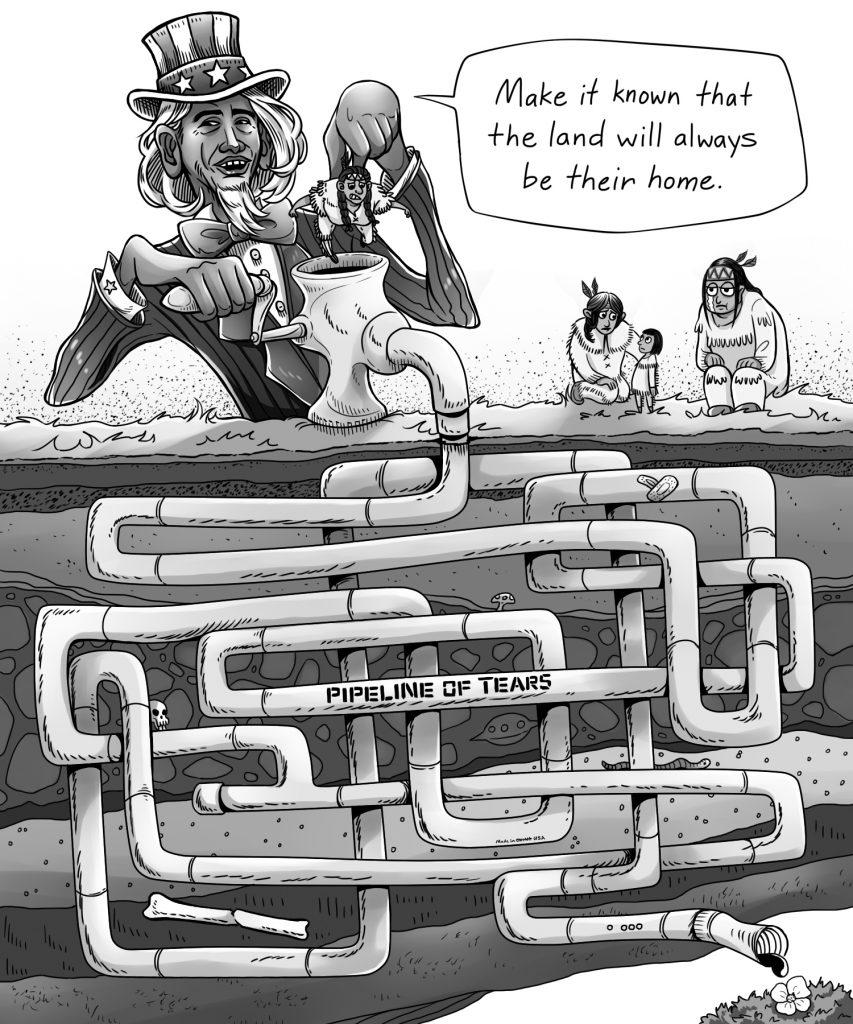Dallas-based company’s threat to desecrate cultural landmark sparks protests due to past governmental practices.
By Monica Mitrovic
Contributing Writer

Many Americans will be indulging in turkey, pie and America’s favorite pastime – football – on Nov. 24.
But the Standing Rock Sioux tribe, along with environmentalists and other Native Americans, will continue protesting the Dakota Access Pipeline Project that threatens their water supply and encroaches on their land.
In 2016, Energy Transfer Partners, a Dallas-based natural gas and propane company, threatened the livelihood of the Sioux and their lands with the Dakota Access Pipeline. The pipeline will assist the easy transport of crude oil through four states — North Dakota, South Dakota, Iowa and Illinois — in a safe and environmentally responsible manner, according to the company’s fact website daplpipelinefacts.com.
But the construction of the pipeline endangers the Sioux people’s water supply, trespasses on sacred land promised to the Sioux tribe and disturbs burial grounds.
In 1851, the Treaty of Fort Laramie gifted the Sioux tribe various lands, establishing the Great Sioux Reservation. According to Lynda Mapes, an environmental reporter for The Seattle Times, the treaty was rewritten countless times, and when tribal members didn’t agree to the rewrites, acts of Congress just stole the Sioux people’s land.
In 1997, the government seized the Sioux’s most sacred lands, the Black Hills, according to pbs.org.
“It’s sad because businesses don’t care about [the Sioux’s] traditions,” Minhal Bhojani, a student, said. He also said if the pipeline disturbed a military graveyard, people would be outraged.
The original pipeline route was supposed to cross the Missouri River north of Bismarck, North Dakota, according to The New Yorker. Authorities were concerned an oil spill could contaminate Bismarck’s drinking water, so the pipeline was moved half a mile south. The new location is closer to the Standing Rock Sioux Reservation.
According to Mapes, the U.S. Army Corps of Engineers flooded much of the remaining Sioux land in 1958, stashing an important reservoir behind a dam. The Sioux people were never consulted and never gave their consent. Energy Transfer Partners wants to tunnel under that reservoir to complete the pipeline construction, which is why protestors are determined to prevent this and fight for Native American rights.
This instance is the latest in a series of events in which Native Americans have been forced to give up their lands throughout U.S. history.
In 1795, the Treaty of Greenville signed over most of the Native American lands in Ohio to the U.S., according to Ohio History Central. In 1809, the Treaty of Fort Wayne forced Native Americans to cede 3 million acres of land under questionable circumstances. According to the U.S. National Library of Medicine, Tecumseh and Tenskwatawa, Shawnee brothers, mobilized Native American tribes to stop westward expansion.
Tecumseh is famous for his statement regarding Americans at the time: “We gave them forest-clad mountains and valleys full of game, and in return, what did they give our warriors and our women? Rum, trinkets and a grave,” according to firstpeople.us.
The Sioux people’s crisis is reminiscent of the mass relocation and theft Native Americans endured in the past. In the 1800s, tensions between Native Americans and the U.S. increased, and when Andrew Jackson became president, the Indian Removal Act was signed into law on May 30, 1830.
The Indian Removal Act granted lands west of the Mississippi River to Native Americans in exchange for established territories within existing borders, according to the Library of Congress. Although some tribes went peacefully, such as the Cherokee nation, most Native Americans refused to relocate and were then forcibly removed.
This forced removal of Native American tribes became known as the Trail of Tears. Thousands of Native Americans died on the Trail of Tears, which dealt a hard blow to the weary travelers, according to pbs.org.
Today, the Dakota Access Pipeline is the cause of much grief for the Sioux because they must deal with people disrespecting them and trying to steal land that rightfully belongs to the Sioux. Again.
People should carefully reconsider what they’re thankful for this Thanksgiving, especially as the Sioux and their supporters struggle to protect the last of their sacred lands.






